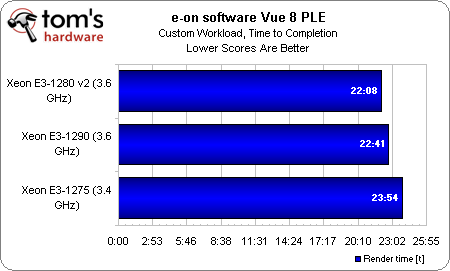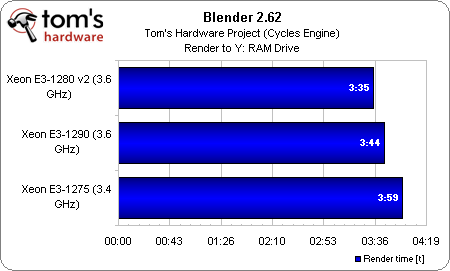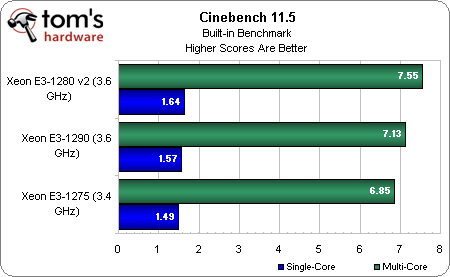Intel Xeon E3-1280 v2 Review: Ivy Bridge Goes Professional
Intel recently introduced its Xeon E3-1200 v2 CPUs, based on the Ivy Bridge architecture. Though they're very similar to the third-generation desktop Core chips, ECC memory support, four extra PCIe 3.0 lanes, and attractive pricing grab our attention.
Benchmark Results: Rendering
Our Vue 8 render workload takes more than 20 minutes, and Intel’s Ivy Bridge architecture helps cut more than 30 seconds from the task at the same 3.6 GHz clock rate. Shifting from Sandy to Ivy Bridge and adding 200 MHz nearly shaves off two minutes.
In testing Blender’s newer Cycles engine, we see slight scaling between last-gen and current-gen Xeon E3 CPUs. Not surprisingly, the -1275 finishes last due to its Sandy Bridge design and slower clock rate. The -1280 v2 places first again thanks to Intel’s Ivy Bridge architecture and 3.6 GHz base frequency.
Although we’d expect similar behavior from SolidWorks as Vue and Blender, the Ivy Bridge-based Xeon E3-1280 v2 establishes a larger advantage over the Sandy Bridge architecture in this one test.
Subtle improvements each step of the way make it pretty clear than upgrading a previous-generation workstation with a newer Xeon E3 probably won’t do much for performance (the same conclusion we drew about Intel’s desktop-oriented Core i7-3770K). However, the Xeon E3-1280 v2 is quantifiably faster than the Xeon E3-1290. So, if you held off on upgrading to a Sandy Bridge-based part, the second-gen E3s should yield more bang for your buck.
Get Tom's Hardware's best news and in-depth reviews, straight to your inbox.
Current page: Benchmark Results: Rendering
Prev Page Benchmark Results: Adobe CS 5.5 Next Page Benchmark Results: Transcoding-
aqualipt Meeeh, Ivy bridge is a disappointment for the hardcore PC users, although is great for mobile users.Reply -
tomfreak ReplyIvy Bridge Goes Professional
Need Ivy Bridge Goes budget.
Still Waiting this.... i3, Pentium G -
bit_user Skip.Reply
I went with a Sandybridge E5-1620 + discrete graphics. Twice the memory bandwidth. Twice the PCIe lanes. Comparable price. And the raw performance of the cores is only a couple % slower. A good tradeoff for GPU compute.
-
mousseng Okay, I'll take your word for it that a $600+ Xeon can be better value in certain scenarios than an i7. But how exactly is it better value than the ~$230 E3-1230v2, which (as far as I can tell) is exactly the same, only clocked a few hundred MHz lower? Is the need to squeeze every ounce of performance out of the server-class CPUs so great that Intel can demand a $400 price hike for 300MHz?Reply -
The 3Ds Max test doesn't make any sense unless you mention which renderer you're using (Mental Ray? Vray? Scanline?). Also it would be nice if you compared against desktop processors to see if it's worth splashing out on the XeonsReply
-
PreferLinux Skeletor1The 3Ds Max test doesn't make any sense unless you mention which renderer you're using (Mental Ray? Vray? Scanline?). Also it would be nice if you compared against desktop processors to see if it's worth splashing out on the XeonsYou don't buy Xeons for performance, you buy them for reliability. The performance for clock speed is exactly the same.Reply -
PreferLinux moussengOkay, I'll take your word for it that a $600+ Xeon can be better value in certain scenarios than an i7. But how exactly is it better value than the ~$230 E3-1230v2, which (as far as I can tell) is exactly the same, only clocked a few hundred MHz lower? Is the need to squeeze every ounce of performance out of the server-class CPUs so great that Intel can demand a $400 price hike for 300MHz?If you need the single-threaded performance, you need it. You can't get that performance by combining multiple systems. In servers or render farms, you can just add a few more machines to make up for the lesser performance, because they are dealing with tasks that are extremely well threaded – so you don't buy the fastest option, you buy the best value option. But in some cases, the single threaded performance is more important (certain workstation tasks) or you are limited to one system (many workstation tasks), so the performance matters more than value until the performance stops making a significant difference.Reply
And I wouldn't say that it is better value, rather I'd say that it is necessary for the extra reliability. -
mandrilux Nice review, but i'd like to view a comparasion between E3-1245v2 or E3-1275v2 versus I7-3770 or I7-3770K over a motherboard with chipset Z77 like Asrock. Because the E3 is cheaper than I7 and supports same socket.Reply
Thanks. -
mandrilux Nice review, but i'd like to view a comparasion between E3-1245v2 or E3-1275v2 versus I7-3770 or I7-3770K over a motherboard with chipset Z77 like Asrock. Because the E3 is cheaper than I7 and supports same socket.Reply
Thanks. -
ekho Intel doesn't compete hard these days.Reply
It does whatever it wants.
AMD or ARM-BASED are not serious competitors at least for about next 2 years I guess.





